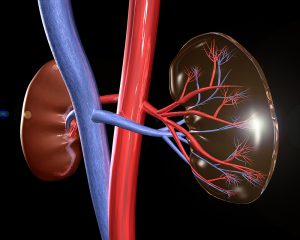Duke Study Will Examine Patients With AKI

Recognized as an underdiagnosed condition, acute kidney injury (AKI) is a significant contributor to hospital readmissions among patients with chronic illness. To improve the outcomes of patients at high risk of AKI recurrence, Duke nephrologists and internists are collaborating to study the effect of a patient-centered educational intervention for hospitalized patients with AKI.
Clarissa Jonas Diamantidis, MD, who has dual appointments in the Duke Divisions of Nephrology and General Internal Medicine, is helping prepare the research project. Diamantidis also studies access to care for patients with kidney disease, a factor she believes is key to early diagnosis and treatment.
“We see readmission rates running between 12% and 25% for AKI,” Diamantidis says. “Even patients whose kidney function returns fully are at increased risk of developing chronic kidney disease (CKD) in the future.”
In conjunction with her research, Diamantidis has prepared a new treatment modality using electronic learning tools to educate patients, who are often unaware of their kidney disease or risk factors.
The educational tool uses a tablet application to present video and audio vignettes with large, colorful letters to ask questions of patients at risk for kidney disease.
“We pose questions that are critical to patient awareness,” Diamantidis says. “‘Has anyone told you that you might have a problem with your kidneys?’ ‘What kinds of medications do you take?’ ‘Are your medications safe for you?’”
She continues: “These are simple questions presented in an understandable manner, but we believe they will help us educate and engage patients who have experienced AKI and are at risk for CKD.”
AKI typically presents in hospital settings while patients are receiving treatment for comorbidities, Diamantidis says. Routine monitoring can help physicians identify conditions that contribute to AKI. However, patients who don’t recognize their risk or don’t report their health behaviors are not monitored and could face significant risks to their health.
“Community-acquired AKI is the ‘snake in the grass,’” she says. “It’s much more common than we once thought, and it often goes untreated.”
More sophisticated, data-driven screening of electronic medical records for patients at risk may reduce the risk of CKD and AKI, Diamantidis says.
“When practitioners see the condition in a community-based patient during a routine office visit, it means the damage is already happening,” Diamantidis says. “Electronic medical records might help us see these patterns sooner and prevent AKI from occurring in the first place.”